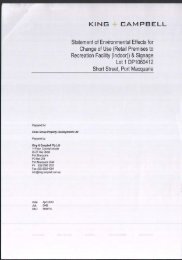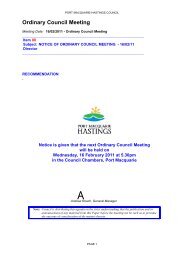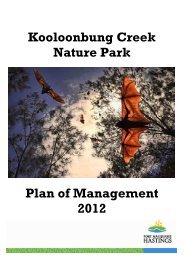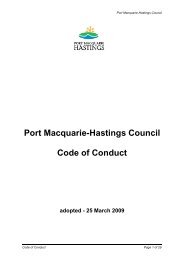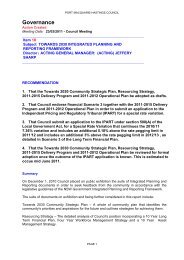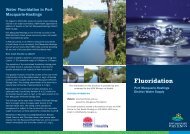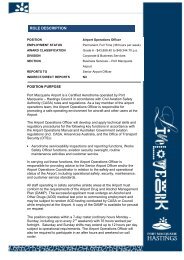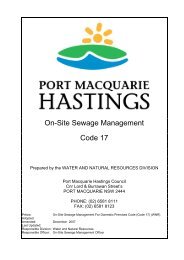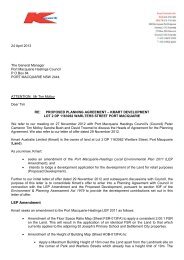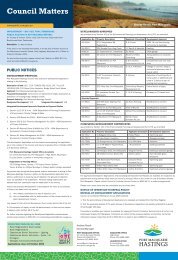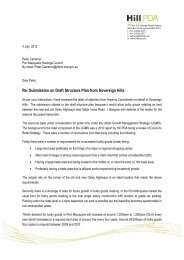Port Macquarie Hastings Retail Strategy Review ... - Hastings Council
Port Macquarie Hastings Retail Strategy Review ... - Hastings Council
Port Macquarie Hastings Retail Strategy Review ... - Hastings Council
Create successful ePaper yourself
Turn your PDF publications into a flip-book with our unique Google optimized e-Paper software.
<strong>Port</strong> <strong>Macquarie</strong><br />
<strong>Hastings</strong> <strong>Retail</strong><br />
<strong>Strategy</strong> <strong>Review</strong><br />
2010<br />
PREPARED FOR<br />
<strong>Port</strong> <strong>Macquarie</strong> <strong>Hastings</strong><br />
<strong>Council</strong><br />
December 2010<br />
Hill PDA<br />
ABN 52 003 963 755<br />
3 rd Floor 234 George Street Sydney<br />
GPO Box 2748 Sydney NSW 2001<br />
t. +61 2 9252 8777<br />
f. +61 2 9252 6077<br />
e. sydney@hillpda.com<br />
w. www.hillpda.com
Hill PDA
QUALITY ASSURANCE<br />
QUALITY CONTROL<br />
This document is for discussion purposes only unless signed and dated by a Principal of Hill PDA.<br />
Adrian Hack<br />
Principal, Hill PDA<br />
B. Town Planning (Hons) (UNSW)<br />
M. Land Ec. (Sydney University)<br />
MPIA<br />
Email: adrian.hack@hillpda.com<br />
Dated December 2010<br />
REPORT DETAILS:<br />
Job Ref No: C10211<br />
Version: Final<br />
Date Printed: 6/12/2010 12:14:00 PM<br />
File Name: C10211 - <strong>Port</strong> <strong>Macquarie</strong> <strong>Hastings</strong> Centres <strong>Strategy</strong> <strong>Review</strong> 061210F.doc
<strong>Port</strong> <strong>Macquarie</strong> <strong>Hastings</strong> <strong>Retail</strong> <strong>Strategy</strong> <strong>Review</strong> 2010<br />
CONTENTS<br />
1. EXECUTIVE SUMMARY .................................................................................................... 6<br />
2. INTRODUCTION ............................................................................................................... 8<br />
2.1 Study Objectives ............................................................................................................... 8<br />
2.2 Methodology ..................................................................................................................... 8<br />
3. HISTORICAL OVERVIEW .................................................................................................. 9<br />
3.1 <strong>Council</strong> Studies and Policies ............................................................................................ 9<br />
3.2 State Government Policies ............................................................................................. 10<br />
4. RETAIL CENTRES ......................................................................................................... 15<br />
4.1 Supply of <strong>Retail</strong> Floor Space .......................................................................................... 15<br />
4.2 <strong>Port</strong> <strong>Macquarie</strong> Greater CBD ......................................................................................... 16<br />
4.3 Local Centres .................................................................................................................. 17<br />
4.4 Performance of <strong>Retail</strong> Centres in <strong>Hastings</strong> .................................................................... 19<br />
4.5 Proposals ........................................................................................................................ 19<br />
5. DEMAND FOR RETAIL SPACE ......................................................................................... 21<br />
5.1 Resident Projections ....................................................................................................... 21<br />
5.2 Resident Spending ......................................................................................................... 22<br />
5.3 Tourism and Regional Spending .................................................................................... 23<br />
5.4 Demand for <strong>Retail</strong> Floor Space ...................................................................................... 24<br />
5.5 Forecast Supply and Demand ........................................................................................ 26<br />
6. RETAIL STRATEGY ....................................................................................................... 28<br />
6.1 Objectives of the <strong>Strategy</strong> .............................................................................................. 28<br />
6.2 New Centres ................................................................................................................... 29<br />
6.3 Greater CBD ................................................................................................................... 29<br />
6.4 Out of Centre <strong>Retail</strong>ing ................................................................................................... 29<br />
7. DRAFT RETAIL POLICY PLAN ........................................................................................ 32<br />
Ref: C10211 4 / 36 Hill PDA
<strong>Port</strong> <strong>Macquarie</strong> <strong>Hastings</strong> <strong>Retail</strong> <strong>Strategy</strong> <strong>Review</strong> 2010<br />
LIST OF TABLES<br />
Table 1 - No. of Shop Front Establishments in <strong>Port</strong> <strong>Macquarie</strong> <strong>Hastings</strong> Shire ........................... 15<br />
Table 2 - Total <strong>Retail</strong> and Shop Front Floor Space by <strong>Retail</strong> Centre (sqm)* ............................... 16<br />
Table 3 - Population Forecast for <strong>Port</strong> <strong>Macquarie</strong> <strong>Hastings</strong> ........................................................ 21<br />
Table 4 - Forecast Household Expenditure Generated by <strong>Port</strong> <strong>Macquarie</strong> <strong>Hastings</strong> LGA<br />
($m2007) .................................................................................................................. 22<br />
Table 5 - Expenditure by <strong>Retail</strong> Store Type ($m2007)................................................................. 23<br />
Table 6 - Forecast Total Expenditure in <strong>Hastings</strong> ($m) ............................................................... 25<br />
Table 7 - Expenditure by <strong>Retail</strong> Store Type ($m) ........................................................................ 25<br />
Table 8 - Demand for <strong>Retail</strong> Floor Space in <strong>Port</strong> <strong>Macquarie</strong> <strong>Hastings</strong> LGA (sqm GLA) .............. 25<br />
Table 9 - Increase in Supply (sqm GLA) ...................................................................................... 26<br />
Table 10 - Centres Hierarchy in 2031 .......................................................................................... 33<br />
Ref: C10211 5 / 36 Hill PDA
<strong>Port</strong> <strong>Macquarie</strong> <strong>Hastings</strong> <strong>Retail</strong> <strong>Strategy</strong> <strong>Review</strong> 2010<br />
1. EXECUTIVE SUMMARY<br />
This report has been prepared by Hill PDA for <strong>Port</strong> <strong>Macquarie</strong> <strong>Hastings</strong> <strong>Council</strong> as a review of <strong>Council</strong>’s <strong>Retail</strong><br />
<strong>Strategy</strong> adopted in 2004. This report presents the findings of an analysis of the future needs for retail and<br />
commercial services in the LGA to the year 2031, as well as current proposals and the implications on <strong>Council</strong>’s<br />
existing retail strategy. This report feeds into the Local Growth Management <strong>Strategy</strong>.<br />
<strong>Port</strong> <strong>Macquarie</strong> <strong>Hastings</strong> LGA has around 792 shop front premises totalling some 136,000sqm of lettable floor<br />
space. Floor space is spatially separated into a number of retail centres. The largest concentration is the Greater<br />
<strong>Port</strong> <strong>Macquarie</strong> CBD which comprises Settlement City, <strong>Port</strong> <strong>Macquarie</strong> Town Centre (which includes <strong>Port</strong> Central<br />
and surrounding shop front spaces), Gordon Street precinct and Munster Village. The Greater CBD comprises<br />
88,000sqm (65% of the LGA shop front floor space). The balance is distributed into 14 centres of varying sizes –<br />
Wauchope and Laurieton being the next 2 largest centres with approximately 12,000 and 11,000sqm respectively.<br />
Of the 136,000sqm of shop front space around 115,000sqm is occupied retail space (excluding retail space<br />
outside the centres). The balance is vacant space and non-retail commercial uses.<br />
<strong>Port</strong> <strong>Macquarie</strong> <strong>Hastings</strong> LGA had a population of 71,285 people in 2006 and is expected to reach 104,591 people<br />
by 2031. Population growth (from 1.3% increasing to 1.7% per annum) as well as real growth in retail spend per<br />
capita (of around 1.0% to 1.5% per annum) translates to growth in expenditure from $807m in 2007 to a forecast<br />
of $1.6 billion in 2031. Tourism and spending in the <strong>Port</strong> <strong>Macquarie</strong> <strong>Hastings</strong> centres from residents outside the<br />
LGA account for a further $160m to $180m per annum. Increasing expenditure increases demand for retail floor<br />
space within the commercial centres from 125,000sqm in 2007 to 210,000sqm by 2031.<br />
There are a number of proposals for expansion of retail floor space – the main ones being Hayward Street<br />
(4,000sqm), Thrumster (7,500sqm), expansion of Settlement City (10,000sqm), Expansion of Laurieton<br />
(3,000sqm), Wauchope (3,600sqm), St Josephs School site (20,000sqm), <strong>Hastings</strong> River Drive (1,500sqm) and<br />
Lake Cathie / Bonny Hills (5,000sqm). Assuming all proposals are complete by 2016 then there will be almost<br />
10% oversupply of retail floor space in the LGA. By 2022 however growth in demand will eradicate the condition<br />
of oversupply. By 2031 the LGA will require a further 40,000sqm over and above what is existing and currently<br />
proposed for.<br />
Objectives of the <strong>Strategy</strong> include:<br />
• Provide quantity, quality and convenience for consumers as well as a wide range of shopping opportunities<br />
and commercial experiences;<br />
• Provide for further growth in retail and commercial space to meet growth in demand generated by<br />
population and household growth;<br />
• Protect the integrity and viability of existing centres to the extent that they continue to perform a valuable<br />
community function;<br />
• Protect the integrity and viability of the Greater <strong>Port</strong> <strong>Macquarie</strong> CBD; and<br />
• Protect current employment levels in retailing and hospitality industries for the residents of the LGA and<br />
expand opportunities for further employment.<br />
Ref: C10211 6 / 36 Hill PDA
<strong>Port</strong> <strong>Macquarie</strong> <strong>Hastings</strong> <strong>Retail</strong> <strong>Strategy</strong> <strong>Review</strong> 2010<br />
Strategies include:<br />
• Prohibit any new centres with the exception of Thrumster (with a maximum lettable area of 7,500sqm) and<br />
Area 14 Lake Cathie / Bonny Hills (with a maximum size of 5,000sqm).<br />
• In order to ensure the viability of the <strong>Port</strong> <strong>Macquarie</strong> Town Centre it is recommended that any proposals for<br />
redevelopment and expansion of retail space in the Town Centre area be supported – particularly proposals<br />
that will introduce new retailers and new formats. This is the case even if it results in some “oversupply” of<br />
retail space throughout the LGA.<br />
• Discourage or prohibit out-of-centre retailing unless it (a) complies with the definition of bulky goods retailing<br />
under the LEP or Standard LEP Template and is located on Lake Road, <strong>Hastings</strong> River Drive or Oxley<br />
Highway, or (b) complies with the definition of convenience retailing and is no larger than 200sqm.<br />
Ref: C10211 7 / 36 Hill PDA
<strong>Port</strong> <strong>Macquarie</strong> <strong>Hastings</strong> <strong>Retail</strong> <strong>Strategy</strong> <strong>Review</strong> 2010<br />
2. INTRODUCTION<br />
This report has been prepared by Hill PDA for <strong>Port</strong> <strong>Macquarie</strong> <strong>Hastings</strong> <strong>Council</strong> as a review of <strong>Council</strong>’s <strong>Retail</strong><br />
<strong>Strategy</strong> adopted in 2004. This report presents the findings of an analysis of the future needs for retail and<br />
commercial services in the LGA to the year 2031, as well as current proposals and the implications on <strong>Council</strong>’s<br />
existing retail strategy.<br />
2.1 Study Objectives<br />
In order to develop and evaluate a range of options for the planning and management of retailing in the LGA it is<br />
necessary to have a clear set of objectives. At the commencement of the study key objectives were established –<br />
these being:<br />
• Provide quantity, quality and convenience for consumers as well as a wide range of shopping opportunities<br />
and commercial experiences;<br />
• Provide for further growth in retail and commercial space to meet growth in demand generated by<br />
population and household growth;<br />
• Protect the integrity and viability of existing centres to the extent that they continue to perform a valuable<br />
community function;<br />
• Protect the integrity and viability of the Greater <strong>Port</strong> <strong>Macquarie</strong> CBD; and<br />
• Protect current employment levels in retailing and hospitality industries for the residents of the LGA and<br />
expand opportunities for further employment.<br />
2.2 Methodology<br />
The tasks undertaken in the preparation of this report included:<br />
• Forecast population growth, resident and tourism spending in the LGA to 2031;<br />
• Forecast demand for retail floor space based on forecast retail spending;<br />
• Identify areas of shortfall in supply by area and retail store type;<br />
• Identify proposals that will increase supply;<br />
• <strong>Review</strong> <strong>Council</strong>’s existing strategy in its ability to address current and foreseeable issues;<br />
• Make recommendations regarding the planning for, and control of, retail provisions in the LGA; and<br />
• Draft the revised Centres Policy.<br />
Ref: C10211 8 / 36 Hill PDA
<strong>Port</strong> <strong>Macquarie</strong> <strong>Hastings</strong> <strong>Retail</strong> <strong>Strategy</strong> <strong>Review</strong> 2010<br />
3. HISTORICAL OVERVIEW<br />
3.1 <strong>Council</strong> Studies and Policies<br />
Early Studies<br />
The first major study on retailing in <strong>Port</strong> <strong>Macquarie</strong> <strong>Hastings</strong> was undertaken by Plant Location International (PLI)<br />
in 1985. The study included a series of recommendations including the recognition of <strong>Port</strong> <strong>Macquarie</strong> as the<br />
major centre and the need for a discount department store to reinforce this role. In 1990 the study was updated<br />
by PLI.<br />
1999 <strong>Review</strong><br />
In 1999 <strong>Council</strong> reviewed the earlier studies with two background reports prepared by G. W. Smith of Design<br />
Collaborative including “A Report on a <strong>Retail</strong> Policy Plan” for <strong>Hastings</strong> <strong>Council</strong> and a discussion paper titled<br />
“Shopping After 2000”. The papers included recognition of a hierarchy of centres, measures to protect the Greater<br />
CBD of <strong>Port</strong> <strong>Macquarie</strong> and a number of other related issues. The reports did not agree with the “Greater CBD”<br />
concept as the distances between Settlement City, <strong>Port</strong> <strong>Macquarie</strong> central and Gordon Street were too excessive<br />
for the Greater CBD to function as a single centre.<br />
The report suggested that a better long term alternative to expansions in the Greater CBD is a new “out-of-town”<br />
centre in the Sancrox-Thrumster area to ultimately include a department store and a large range of retailers. An<br />
area of at least 20 hectares was recommended to be preserved for this option.<br />
2004 <strong>Retail</strong> <strong>Strategy</strong> <strong>Review</strong><br />
In 2004 Leyshon Consulting prepared a “<strong>Retail</strong> <strong>Strategy</strong> <strong>Review</strong>” which was largely adopted by <strong>Council</strong> for its<br />
centres policy. <strong>Council</strong> largely dismissed the idea of a large regional or sub-regional centre outside the existing<br />
Greater CBD. Instead it has maintained the hierarchy with the Greater CBD as the main centre, Wauchope and<br />
Laurieton as the district CBD (or town centres) and the remaining centres as villages or neighbourhoods.<br />
Only three new centres were identified – all being neighbourhood centres in:<br />
• Major Innes Drive (now operating);<br />
• Area 13 (Thrumster); and<br />
• Area 14 (Bonny Hills).<br />
Each of these centres was to be capped in size to a retail floor space of 5,000sqm. The capped area for<br />
Thrumster was increased to 7,500sqm following a review of the economic impacts by Hill PDA in 2007.<br />
This Hill PDA report is a 5 year review of the 2004 document and <strong>Council</strong>’s <strong>Retail</strong> <strong>Strategy</strong>.<br />
Ref: C10211 9 / 36 Hill PDA
<strong>Port</strong> <strong>Macquarie</strong> <strong>Hastings</strong> <strong>Retail</strong> <strong>Strategy</strong> <strong>Review</strong> 2010<br />
3.2 State Government Policies<br />
Draft Integrated Land Use and Transport Policy Package and Draft SEPP 66<br />
The former strategy of Draft SEPP 66 sought to achieve “…the better integration of land use and transport<br />
planning at the local level” particularly in relation to the preparation of environmental planning instruments,<br />
development control plans and the like and the consideration of development and applications. The aims of SEPP<br />
66 were to ensure that urban structure, building forms, land use locations, development designs, subdivision and<br />
street layout help achieved the following planning objectives:<br />
“(a) improving accessibility to housing, employment and services by walking, cycling, and public transport,<br />
(b) improving the choice of transport and reducing dependence solely on cars for travel purposes,<br />
(c) moderating growth in the demand for travel and the distances travelled, especially by car,<br />
(d) supporting the efficient and viable operation of public transport services,<br />
(e) providing for the efficient movement of freight.”<br />
Draft SEPP 66 required that before granting consent for development <strong>Council</strong> must consider whether carrying out<br />
of the development will further the aims and the planning objectives of the policy and whether the development is<br />
consistent with the policy on location of specific land uses and the general policies in the Integrated Land Use and<br />
Transport Policy Package.<br />
Interestingly there have been some Land and Environment Court judgements that have used Draft SEPP 66<br />
principles in the consideration and refusal of applications (refer to Terrace Tower Holdings Pty Limited v<br />
Sutherland Shire <strong>Council</strong> [No_2] [2002] NSWLEC 150 and Stadurn Pty Limited v Blacktown City <strong>Council</strong> [2004]<br />
NSWLEC 348).<br />
Regional Strategies<br />
The Draft Mid-North Coast Regional <strong>Strategy</strong> identifies a hierarchy of centres with <strong>Port</strong> <strong>Macquarie</strong> being a major<br />
regional centre (as well as Taree, Grafton and Coffs Harbour), Kempsey as a major town, Laurieton, Wauchope<br />
and Lake Cathie/Bonny Hills as town centres.<br />
As a major regional centre <strong>Port</strong> <strong>Macquarie</strong> has the majority of growth and employment opportunities and is the<br />
major centre for state and regional services. These centres are also expected to have “a concentration of medium<br />
to high density living, business employment and professional services, higher order shopping, warehouses,<br />
transport logistics and bulky goods operations”.<br />
Town centres have more limited trade areas. They have a small to medium scale concentration of retail, health<br />
and other services with lower density residential. They are reliant on major regional centres and major towns for<br />
high order services, retailing and employment.<br />
Page 25 of the <strong>Strategy</strong> states that "Fragmentation and out-of centre retailing should be resisted unless<br />
compelling reasons exist in order to maintain the healthy retail and service functioning of particular centres in the<br />
Ref: C10211 10 / 36 Hill PDA
<strong>Port</strong> <strong>Macquarie</strong> <strong>Hastings</strong> <strong>Retail</strong> <strong>Strategy</strong> <strong>Review</strong> 2010<br />
region." This is key strategy enabling <strong>Council</strong> to protect and maintain the retail hierarchy and the viability of<br />
existing centres.<br />
NSW Draft Centres Policy<br />
Recently there has been the growing awareness and investigation of barriers to competition in Australia,<br />
particularly in the retail industry. As a result of these investigations the Australian Government directed state<br />
governments and planning authorities to review the flexibility of planning regulations and policies regarding retail<br />
development. In response the NSW Department of Planning released the draft Centres Policy in April 2009.<br />
The sensitivity of Australian households to retail prices is particularly acute given that Australian’s spend between<br />
12 and 14% of their after tax income 1 per annum on basic grocery items. Coupled with the pressures of the<br />
economy, Australian’s have been experiencing an increase in basic grocery prices over the past five years. In fact<br />
the rate of grocery price increases has been significantly greater (an estimated 6% 2 ) than the headline Australian<br />
inflation rate and shows no present signs of abatement.<br />
The growth of grocery prices raised significant political interest and debate over the course of 2008 and 2009. In<br />
response the Australian Government instructed the Australian Competition and Consumer Commission (ACCC) to<br />
undertake a full inquiry into factors potentially affecting retail prices including the competitiveness of the retail<br />
industry and barriers to the entry of new retailers.<br />
Relevant to this study, the ACCC Inquiry identified the ‘very significant barriers to entry for large-format, one stop<br />
shop supermarkets’ as a prominent issue. The identified barriers included:<br />
• Access to retail units within shopping centres owing to restrictive provisions on centre leases;<br />
• Tactics applied by major retailers to protect their interests against prospective retail developments; and<br />
• Access to suitable development sites owing to land use zones.<br />
To address the matter of access to sites for the retail industry, the inquiry recommended that governments across<br />
Australia look at new ways to incorporate competition into planning decisions. It stated that “Particular regard<br />
should be had to whether the [development] proposal will facilitate the entry of a supermarket operator not<br />
currently trading in the area”. 3<br />
In response to the planning recommendations provided by the ACCC Inquiry and the current economic climate,<br />
the NSW Department of Planning prepared and released the Draft Centres Policy for commercial and retail<br />
development in NSW.<br />
The Policy was released in April 2009 recognising that the market is best placed to determine the need for<br />
development and the supply of available floor space to accommodate demand. The role of the planning system is<br />
to accommodate this need whilst regulating its location and scale.<br />
1. Based on Household Expenditure Survey (ABS cat.no. 6530.0) and Census of Population and Housing (ABS cat. No. 2003.0) data<br />
2. Urbis <strong>Retail</strong> Perspectives, June 2009<br />
3<br />
Report to the ACCC Inquiry into the Competitiveness of <strong>Retail</strong> Prices for Standard Groceries, July 2008, Australian Competition and<br />
Consumer Commission (Page xix)<br />
Ref: C10211 11 / 36 Hill PDA
<strong>Port</strong> <strong>Macquarie</strong> <strong>Hastings</strong> <strong>Retail</strong> <strong>Strategy</strong> <strong>Review</strong> 2010<br />
In light of these fundamental principles, the Draft Centres Policy focuses around six key principles. The principles<br />
relate to:<br />
1. The need to reinforce the importance of centres and clustering business activities;<br />
2. The need to ensure the planning system is flexible, allows centres to grow and new centres to form;<br />
3. The market is best placed to determine need. The planning system should accommodate this need whilst<br />
regulating its location and scale.<br />
4. <strong>Council</strong>s should zone sufficient land to accommodate demand including larger retail formats;<br />
5. Centres should have a mix of retail types that encourage competition; and<br />
6. Centres should be well designed to encourage people to visit and stay longer.<br />
The Draft Policy has been publicly exhibited. The DoP is presently reviewing public submissions and aims to<br />
amend the policy in response, where appropriate. It is understood that the DoP seeks to release the amended<br />
policy for adoption towards the end of 2009. The six key principles are discussed below.<br />
Principle 1: <strong>Retail</strong> and Commercial Activity should be Located within Centres<br />
The first principle of the Draft Centres Policy reinforces the longstanding strategy to concentrate the predominant<br />
share of retail and business floor space within town centres. The clustering of uses within centres is justified for<br />
environmental and economic reasons. By way of example, focusing uses within centres makes efficient use of<br />
existing infrastructure including public transport, can improve business efficiency and productivity and allow for a<br />
range of uses to be provided to meet consumer needs.<br />
Principle 2: Centres should be able to Grow and New Centres Form<br />
The Draft Centres Policy identifies that areas experiencing significant increases in population and real income<br />
must be dynamic and respond to “prevailing market demands” through the extension of existing centres or the<br />
growth of new ones.<br />
Principle 2 of the Draft Centres Policy recommends the rezoning of land in appropriate centre locations or<br />
locations adjacent to centres in order to facilitate business expansion and to enable new businesses to enter the<br />
market.<br />
Principle 3: Market Determines Need for Development, Planning Regulates Location and Scale<br />
The third principle of the Draft Centres Policy identifies that the market is best placed to determine demand for<br />
retail and commercial development. Accordingly, the role of the planning system is not to assess the<br />
appropriateness of development on the basis of demand, but rather to make an assessment as to the external<br />
costs and benefits.<br />
There have been a number of criticisms with the policy including ambiguity with and potential inconsistency or<br />
conflicts between the principles. We understand that the NSW Department of Planning is currently working to<br />
remove these ambiguities and inconsistencies for the final policy and that there may also be differences between<br />
metropolitan and non-metropolitan policies.<br />
Ref: C10211 12 / 36 Hill PDA
<strong>Port</strong> <strong>Macquarie</strong> <strong>Hastings</strong> <strong>Retail</strong> <strong>Strategy</strong> <strong>Review</strong> 2010<br />
Principle 4: Ensuring the Supply of Floor Space Accommodates Market Demand<br />
The fourth principle of the Draft Centres Policy emphasises the importance of competition between retailers. The<br />
key intention of this principle is to create better quality, cheaper and more accessible goods for all consumers<br />
through enhanced competition. To support opportunities for greater competition, the Draft Policy requires councils<br />
to ensure that there is sufficient zoned land to enable additional (and new) large format retailers to enter the NSW<br />
retail market.<br />
Principle 5: Support a Wide Range of <strong>Retail</strong> and Commercial Premises and Contribute to a Competitive<br />
<strong>Retail</strong> Market<br />
Principle 5 of the Draft Centres Policy states that, subject to meeting the appropriate location and design criteria,<br />
the zoning and development assessment process should not consider impacts between existing and proposed<br />
retailers as a planning consideration.<br />
Whilst the Principle seeks to extract the matter of individual business impact from planning assessment (in<br />
keeping with the findings of various Land and Environment Cases) the effect of a proposed development to the<br />
function and vitality of existing and planned centres will remain as an important local issue.<br />
In Fabcot Pty Ltd v Hawkesbury City <strong>Council</strong> (97) LGERA, Justice Lloyd noted "economic competition between<br />
individual trade competitors is not an environmental or planning consideration to which the economic effect<br />
described in s 90(1)(d) is directed. The Trade Practices Act 1974 (Cth) and the Fair Trading Act 1987 (NSW) are<br />
the appropriate vehicles for regulating competition. Neither the <strong>Council</strong> nor this Court is concerned with the mere<br />
threat of economic competition between competing business…. It seems to me that the only relevance of the<br />
economic impact of a development is its effect ‘in the locality’…”.<br />
In Kentucky Fried Chicken Pty Ltd v Gantidis (1979) 140 CLR 675 at 687 Justice Stephen noted that “if the<br />
shopping facilities presently enjoyed by a community or planned for it in the future are put in jeopardy by some<br />
proposed development, whether that jeopardy be due to physical or financial causes, and if the resultant<br />
community detriment will not be made good by the proposed development itself, that appears to me to be a<br />
consideration proper to be taken into account as a matter of town planning... However, the mere threat of<br />
competition to existing businesses if not accompanied by a prospect of a resultant overall adverse effect upon the<br />
extent and adequacy of facilities available to the local community if the development be proceeded with, will not<br />
be a relevant town planning consideration.”<br />
The LEC has stated that <strong>Council</strong>s should not be concerned about competition between individual stores as this is<br />
a matter of fair trading. But it should concern itself with impact on established retail centres. These principles<br />
were reiterated by Justice Pearlman in Cartier Holdings Pty Ltd v Newcastle City <strong>Council</strong> and Anor [2001]<br />
NSWLEC 170. “It follows that Section 79C(1)(b) does not require the consent authority to take an approach in<br />
consideration of the relevant matter different from the approach formerly taken in the application of 90(1)(d).”<br />
Principle 6: Contributing to the Amenity, Accessibility, Urban Context and Sustainability of Centres<br />
Principle 6 of the Draft Centres Policy highlights the importance of design quality, development layout, connectivity<br />
and integration. The Policy recognises that good design supports the vitality and function of a town centre as well<br />
Ref: C10211 13 / 36 Hill PDA
<strong>Port</strong> <strong>Macquarie</strong> <strong>Hastings</strong> <strong>Retail</strong> <strong>Strategy</strong> <strong>Review</strong> 2010<br />
as the viability and success of a retail development. Accordingly good quality design is in the interests of planning<br />
authorities, retailers and consumer alike.<br />
Ref: C10211 14 / 36 Hill PDA
<strong>Port</strong> <strong>Macquarie</strong> <strong>Hastings</strong> <strong>Retail</strong> <strong>Strategy</strong> <strong>Review</strong> 2010<br />
4. RETAIL CENTRES<br />
4.1 Supply of <strong>Retail</strong> Floor Space<br />
Excluding the industrial areas <strong>Port</strong> <strong>Macquarie</strong> <strong>Hastings</strong> has almost 800 shop front premises distributed in around<br />
16 centres of varying sizes. Around 600 of theses premises are being used for retailing of goods, 167 are being<br />
used for non-retail commercial purposes (such as real estate, travel agents, finance, medical, etc) and 25 are<br />
vacant. The number of businesses in the retail centres is provided in the table below.<br />
Table 1 - No. of Shop Front Establishments in <strong>Port</strong> <strong>Macquarie</strong> <strong>Hastings</strong> Shire<br />
<strong>Retail</strong> Centre<br />
Catered<br />
Food<br />
Other<br />
Foods<br />
Supermarkets<br />
Department<br />
Stores<br />
Other<br />
Non-<br />
Food<br />
<strong>Retail</strong>*<br />
Total<br />
<strong>Retail</strong><br />
Shop<br />
Front<br />
Commercial**<br />
Shop-<br />
Front<br />
Vacant<br />
TOTAL<br />
Greater CBD<br />
<strong>Port</strong> Central 1 10 3 1 37 52 3 0 55<br />
Balance of <strong>Port</strong> Mac<br />
Town Centre #<br />
2 45 11 0 122 180 83 12 275<br />
Settlement City 1 9 6 1 49 66 3 0 69<br />
Walter St & Foreshore 0 3 1 0 16 20 2 0 22<br />
Gordon Street 1 9 6 0 15 31 12 0 43<br />
Munster Village 1 0 2 0 0 3 0 0 3<br />
TOTAL CBD 6 76 29 2 239 352 103 12 467<br />
Wauchope ## 1 12 13 1 40 67 26 0 93<br />
Laurieton 1 13 11 0 33 58 22 4 84<br />
Lakewood 1 1 1 0 5 8 1 4 13<br />
Lake Innes 1 2 3 0 2 8 1 3 12<br />
Lake Cathie 1 3 3 0 6 13 6 0 19<br />
Lighthouse Plaza 1 3 3 0 5 12 0 0 12<br />
North Haven 2 4 3 0 17 26 1 0 27<br />
Lighthouse Beach 1 2 1 0 5 9 2 0 11<br />
Flynn's Beach 1 5 0 0 4 10 0 0 10<br />
Waniora Parkway 1 1 3 0 3 8 0 0 8<br />
Bonny Hills 0 1 2 0 2 5 2 1 8<br />
Clifton 1 1 2 0 8 12 0 0 12<br />
TOTAL LGA 20 128 75 3 374 600 167 25 792<br />
Notes:<br />
* Other Non-Food <strong>Retail</strong> include selected personal services as defined by ANZIC and include hair and beauty salons, photo processing, dry cleaners,<br />
tailors, key cutters and opticians.<br />
** Commercial refers to shop front commercial users such as real estate agents, travel agents, banks, medical services and the like. It excludes stand<br />
alone commercial buildings and shop-top space.<br />
# As defined by the <strong>Port</strong> <strong>Macquarie</strong>-<strong>Hastings</strong> Development Control Plan 20, <strong>Port</strong> <strong>Macquarie</strong> Town Centre 2009 Edition. It is the area bounded by <strong>Hastings</strong><br />
River to the north, Munster, William and Murray Streets to the east, Gordon Street to the south and Kooloobung Creek to the west.<br />
## Wauchope includes the completed floor area for the new supermarket and specialty stores currently under construction. The supermarket is currently<br />
trading at Timbertown at the time of reporting<br />
Sources: Australian Property <strong>Council</strong> Shopping Directory, Draft <strong>Retail</strong> <strong>Strategy</strong> <strong>Review</strong> (Leyshon Consulting) and Hill PDA Floor Space Surveys 2007 and<br />
2009.<br />
Supply of retail floor space is measured by a combination of the number of stores and floor space (square<br />
metres). Floor space is measured by lettable area (the area leased or potentially leased to a store operator and<br />
includes back of house storage and office) and excludes common areas, plant rooms and loading docks. In the<br />
Ref: C10211 15 / 36 Hill PDA
<strong>Port</strong> <strong>Macquarie</strong> <strong>Hastings</strong> <strong>Retail</strong> <strong>Strategy</strong> <strong>Review</strong> 2010<br />
case of indoor centres such as Settlement City and <strong>Port</strong> Central, it includes the area leased to the shop owners<br />
but excludes common areas, car parking, toilets, plant rooms, fire egress, etc.<br />
Presently there is around 136,000sqm of shop front space in the LGA of which around 115,000sqm is being used<br />
for retailing. Total <strong>Retail</strong> floor space is shown in the table below:<br />
Table 2 - Total <strong>Retail</strong> and Shop Front Floor Space by <strong>Retail</strong> Centre (sqm)*<br />
Centre<br />
Supermarkets &<br />
Grocery Stores Other <strong>Retail</strong> Total <strong>Retail</strong><br />
Non-<strong>Retail</strong><br />
Shop Front<br />
Total Shop<br />
Front Space<br />
Greater CBD<br />
<strong>Port</strong> Central 2,250 12,350 14,600 300 14,900<br />
Balance of <strong>Port</strong> Mac Town Centre 5,500 23,500 29,000 10,450 39,450<br />
Settlement City 4,250 15,050 19,300 500 19,800<br />
Walter St & Foreshore Precincts 0 4,200 4,200 400 4,600<br />
Gordon Street 1,600 5,700 7,300 1,400 8,700<br />
Munster Village 500 250 750 0 750<br />
TOTAL CBD 14,100 61,050 75,150 13,050 88,200<br />
Wauchope 1,600 7,500 9,100 3,000 12,100<br />
Laurieton 2,400 5,450 7,850 2,800 10,650<br />
Lakewood 3,250 600 3,850 450 4,300<br />
Lake Innes 3,000 900 3,900 500 4,400<br />
Lake Cathie 2,800 950 3,750 500 4,250<br />
Lighthouse Plaza 3,000 1,000 4,000 0 4,000<br />
North Haven 200 1,900 2,100 100 2,200<br />
Kew 200 100 300 200 500<br />
Kendall 200 700 900 200 1,100<br />
Lighthouse Beach 100 650 750 150 900<br />
Flynn's Beach 100 800 900 0 900<br />
Waniora Parkway 300 700 1,000 0 1,000<br />
Bonny Hills 0 450 450 250 700<br />
Clifton 200 1,000 1,200 0 1,200<br />
TOTAL LGA 31,450 8,150 115,150 18,550 136,350<br />
* Sources: Australian Property <strong>Council</strong> Shopping Directory, Draft <strong>Retail</strong> <strong>Strategy</strong> <strong>Review</strong> (Leyshon Consulting), Hill PDA Floor Space Surveys 2007 and<br />
recent development applications. Excludes industrial zoned areas.<br />
A description of the retail centres in the LGA is given below.<br />
4.2 <strong>Port</strong> <strong>Macquarie</strong> Greater CBD<br />
<strong>Port</strong> <strong>Macquarie</strong> Greater CBD has almost 80,000sqm of retail<br />
space, almost half of which is in two large indoor shopping<br />
centres. The two indoor centres are <strong>Port</strong> Central and<br />
Settlement City.<br />
• <strong>Port</strong> Central is located at 40 Horton Street in the CBD.<br />
The major anchor tenants include Target (7,100sqm)<br />
and Ritchies IGA Supermarket (2,247sqm). <strong>Port</strong><br />
Central has 54 specialty shops and a total area of<br />
15,000sqm.<br />
<strong>Port</strong> Central<br />
Ref: C10211 16 / 36 Hill PDA
<strong>Port</strong> <strong>Macquarie</strong> <strong>Hastings</strong> <strong>Retail</strong> <strong>Strategy</strong> <strong>Review</strong> 2010<br />
• Around <strong>Port</strong> Central the CBD has around 275 shop-front<br />
premises totalling some 30,000sqm of space fronting<br />
Horton Street, Hay Street, Clarence Street and William<br />
Street. Anchor tenants include a 3,500sqm Coles<br />
supermarket, 2,000sqm Food for Less supermarket and<br />
The Warehouse.<br />
• Settlement City is almost 1.5km west of <strong>Port</strong> Central<br />
shopping centre. The major tenants include Big W<br />
(6,618sqm), Woolworths supermarket (3,968sqm), Base<br />
Warehouse (1,316sqm) and Best & Less (1,175sqm).<br />
There are 66 specialty shops and the centre has a total<br />
area of 19,200sqm. Adjacent to Settlement City are<br />
some 22 retailers with around 5,000sqm of retail space.<br />
Anchor tenants include McDonalds, Go-Lo and a large<br />
Rivers Clothing store.<br />
<strong>Port</strong> <strong>Macquarie</strong> “Main Street”<br />
• Munster shopping centre is a small centre on the corner<br />
of Munster Street and Gordon Street. It comprises a<br />
500sqm Five Star supermarket, a butcher and bakery.<br />
• There are a number of strip shops and an open court<br />
shopping centre on Gordon Street between Gore Street<br />
and <strong>Hastings</strong> River Road. The centre is anchored by a<br />
Settlement City<br />
1,600sqm IGA supermarket, a 1,000sqm fruit and veg store and a 1,500sqm Rebel Sports store. Total<br />
number of premises is around 40 with a total area of around 8,000sqm.<br />
4.3 Local Centres<br />
Wauchope<br />
Wauchope is approximately 16km west from <strong>Port</strong> <strong>Macquarie</strong><br />
town centre. The shopping centre had 93 shop front premises of<br />
which 26 were being used for non-retail commercial services.<br />
Total leaseable floor space is around 13,000sqm of which<br />
around 2,000sqm is occupied by four hardware stores and<br />
3,000sqm is occupied by non-retail commercial services. There<br />
were no vacancies in 2007 at the time of survey. Anchor<br />
tenants included a 1,300sqm IGA supermarket and the<br />
1,300sqm Co-op Department Store (excluding the hardware<br />
component).<br />
Wauchope Shopping Centre<br />
Ref: C10211 17 / 36 Hill PDA
<strong>Port</strong> <strong>Macquarie</strong> <strong>Hastings</strong> <strong>Retail</strong> <strong>Strategy</strong> <strong>Review</strong> 2010<br />
At the time of reporting the IGA supermarket was being redeveloped into a slightly larger Supa-IGA of 1,620sqm,<br />
a 130sqm liquor store and three 50sqm specialty stores. The IGA supermarket is currently trading in a 1,500sqm<br />
store opposite Timbertown during construction in Wauchope.<br />
Laurieton<br />
Laurieton is the largest retail centre in the southern part of the<br />
LGA. Its trade area includes North Haven, Laurieton,<br />
Dunbogan and Kew. It comprises 84 shop front<br />
establishments of which 22 are used for non-retail commercial<br />
services and four are vacant. Total shop front space is<br />
around 10,500sqm of which 7,800sqm is used for retail. The<br />
main anchor tenant is a 2,400sqm Bi-Lo supermarket.<br />
Lake Cathie<br />
Laurieton Main Street<br />
Lake Cathie is approximately 15km South of <strong>Port</strong> <strong>Macquarie</strong><br />
town centre. The shopping centre is anchored by 2,800sqm<br />
Woolworths supermarket and there are 1,100sqm of specialty<br />
retail shops. The total centre is in the order of 4,000sqm. This<br />
is a popular centre for shopping due to its high level of ample<br />
and convenient parking.<br />
Lighthouse Plaza (Tacking Point)<br />
Lighthouse Plaza is a recently rebuilt centre comprising 12<br />
shops anchored by a large 3,000sqm Coles supermarket.<br />
Lake Innes (West <strong>Port</strong> <strong>Macquarie</strong>)<br />
Woolworths - Lake Cathie<br />
Lake Innes Shopping Centre on the corner of Oxley Highway<br />
and Major Innes Drive is the most recent addition to the<br />
hierarchy of centres. It is a local village centre which includes<br />
a 3,000sqm Coles supermarket and 12 specialty shops.<br />
Lakewood<br />
Lakewood is the second youngest centre, only recently built<br />
on the Ocean Drive. It comprises 4,300sqm of space<br />
anchored by a 3,250sqm Woolworths supermarket.<br />
Other Centres<br />
Lighthouse Beach Shopping Centre<br />
Other centres in the local government area are generally small village or neighbourhood centres of less than<br />
1,500sqm. These centres, including Flynns Beach, Lighthouse Beach, Shellys Beach, North Haven, Kew, Kendall<br />
and Clifton Drive, are usually anchored by a small or mini-supermarket – less than 1,000sqm in size.<br />
Ref: C10211 18 / 36 Hill PDA
<strong>Port</strong> <strong>Macquarie</strong> <strong>Hastings</strong> <strong>Retail</strong> <strong>Strategy</strong> <strong>Review</strong> 2010<br />
4.4 Performance of <strong>Retail</strong> Centres in <strong>Hastings</strong><br />
Settlement City is defined by Shopping Centre News as a mini-gun centre (generally centres below 20,000sqm).<br />
It had a reported turnover of $140m in 2008-09. It was ranked number 8 out of the 154 reported centres<br />
throughout Australia. In terms of turnover per square metre it achieved $7,332 ranking number 9 out of the 23<br />
non-metropolitan Mini-Guns in NSW and 8% higher than the median turnover level of 6,800/sqm Australia wide.<br />
We would expect non-metropolitan average to be lower than national average – as much as 10% (based on the<br />
regional differences identified in the 1991-92 ABS <strong>Retail</strong> Survey). Hence Settlement City is trading quite strongly.<br />
In 2005-06 the reported turnover figure of the specialty stores was $7,517/sqm which was 12% higher than the<br />
Australian median at that time.<br />
<strong>Port</strong> Central, which is also defined as a mini-gun had a turnover of $95.8m in 2008-09. This equated to<br />
$6,500/sqm which is a little below the Australian median of $6,800/sqm. However it is ranked number twelve out<br />
of 23 non-metropolitan centres in NSW making it average performance for a non-metropolitan centre of its size.<br />
4.5 Proposals<br />
Current proposals include the following:<br />
• The IGA in Wauchope is currently being redeveloped to accommodate a slightly expanded supermarket,<br />
liquor store and three specialty stores. The future use of the temporary IGA opposite Timbertown is<br />
unknown.<br />
• A stand alone Coles supermarket of approximately 3,000sqm on the edge of the village centre on Wallace<br />
Street beside the railway line was approved by <strong>Council</strong>. Work is yet to commence.<br />
• A proposal for some expansion in Laurieton including a new Coles Supermarket and the conversion of the<br />
existing Bi-Lo supermarket into a Target Country store was approved. Work is yet to commence.<br />
• Settlement City plans to undergo an expansion of around 15,000sqm of which 10,000sqm will be strip retail,<br />
restaurants and the like and 5,000sqm will be recreational facilities including cinemas and gymnasium.<br />
Most likely opening date will be 2012-13.<br />
• <strong>Council</strong> is currently preparing an LEP amendment for land at Warlters Street, adjoining Settlement City, to<br />
allow for future retail development. <strong>Council</strong> has resolved to permit up to 9,000m2 between 2013 and 2015,<br />
with further retail development possible after 2015. Preliminary plans indicate capacity for retail<br />
development in the order of 20,000m2 floorspace.<br />
• Sovereign Hills (Thrumster Area 13) will ultimately have a centre capacity of 7,500sqm to service the future<br />
10,000-11,000 residents of Thrumster. A Woolworths based centre has been approved for the first stage<br />
which is likely to open in around 2012.<br />
• A new shopping centre in Bonny Hills of up to 5,000sqm will service the local area.<br />
• A 4,000sqm Coles supermarket with 316 public carparking spaces has been approved on <strong>Council</strong> owned<br />
land between Gordon Street and Hayward Street at the southern end of the <strong>Port</strong> <strong>Macquarie</strong> Town Centre.<br />
Ref: C10211 19 / 36 Hill PDA
<strong>Port</strong> <strong>Macquarie</strong> <strong>Hastings</strong> <strong>Retail</strong> <strong>Strategy</strong> <strong>Review</strong> 2010<br />
• A 1,500sqm general store (possibly to be operated by ALDI) has been approved on <strong>Hastings</strong> River Drive.<br />
Ref: C10211 20 / 36 Hill PDA
<strong>Port</strong> <strong>Macquarie</strong> <strong>Hastings</strong> <strong>Retail</strong> <strong>Strategy</strong> <strong>Review</strong> 2010<br />
5. DEMAND FOR RETAIL SPACE<br />
This section forecasts demand for retail space in the <strong>Port</strong> <strong>Macquarie</strong>-<strong>Hastings</strong> LGA during the period from 2006 to<br />
2031. Demand comes from three main sources of expenditure:<br />
• Residents of <strong>Hastings</strong>;<br />
• Residents of surrounding local government areas; and<br />
• Tourists and visitors.<br />
5.1 Resident Projections<br />
The increase in availability of private motor transport over this post-war period resulted in significant demand for<br />
residential development in coastal areas away from traditional rail-based inland townships. The primary housing<br />
market role that <strong>Port</strong> <strong>Macquarie</strong>-<strong>Hastings</strong> played during the post-war period was to attract families and retirees<br />
from areas further south, in particular the Sydney region. There has also been demand for housing resulting from<br />
the children of those families setting up their own households. This pattern is likely to continue into the future,<br />
driving development on the outskirts of <strong>Port</strong> <strong>Macquarie</strong> and in the Camden Haven.<br />
In 2001, the total population of the local government area was estimated to be 65,378 people. By 2006 it had<br />
increased to 71,285 – an average annual increase of 1.75%. Population growth has slowed slightly to 1.3% per<br />
annum and is expected to continue until 2011 before regaining to 1.7% per annum. The forecast of population is<br />
provided below:<br />
Table 3 - Population Forecast for <strong>Port</strong> <strong>Macquarie</strong> <strong>Hastings</strong><br />
Locality 2006 2011 2016 2021 2026 2031<br />
Camden Haven East 6,191 6,498 6,720 6,828 6,929 7,072<br />
Camden Haven West 2,777 2,845 3,753 4,961 6,048 7,015<br />
Flynns Beach 3,143 3,248 3,314 3,372 3,427 3,485<br />
Innes Peninsula 2,175 2,982 4,017 4,748 5,630 6,302<br />
Kings Creek - Sancrox - Lake Innes 2,467 2,668 2,898 3,177 3,512 4,182<br />
Lake Cathie - Bonny Hills 5,806 6,275 6,763 7,546 8,576 9,801<br />
Lighthouse Beach - Greenmeadows 11,388 11,882 12,568 12,965 13,043 12,996<br />
<strong>Port</strong> <strong>Macquarie</strong> Remainder 9,564 9,793 9,901 9,958 10,195 10,347<br />
Rural North 3,266 3,261 3,251 3,336 3,472 3,570<br />
Rural West - South 3,119 3,119 3,111 3,137 3,188 3,245<br />
Shelly Beach - Bellevue Hill 10,587 10,705 10,929 10,929 11,237 11,359<br />
Thrumster 106 660 2,488 5,125 7,681 10,090<br />
Town Beach - CBD 1,329 1,412 1,503 1,602 1,704 1,810<br />
Wauchope 6,219 6,913 7,587 8,269 8,936 9,531<br />
Westport 3,148 3,310 3,455 3,563 3,674 3,786<br />
TOTAL 71,285 75,571 82,258 89,707 97,252 104,591<br />
Source: <strong>Port</strong> <strong>Macquarie</strong> <strong>Hastings</strong> <strong>Council</strong> 2009<br />
Ref: C10211 21 / 36 Hill PDA
<strong>Port</strong> <strong>Macquarie</strong> <strong>Hastings</strong> <strong>Retail</strong> <strong>Strategy</strong> <strong>Review</strong> 2010<br />
5.2 Resident Spending<br />
In addition to population growth there has been real growth in retail spend resulting from increasing affluence and<br />
economic materialism. From 1991 to 2005 growth in retail spend per capita was around 1.9%. There have been<br />
periods however where growth has been negative such as 1986 to 1991 and during 2007 to 2008 when rising<br />
interest rates and petrol prices saw households reducing spend. The more recent GFC and worsening job security<br />
has had some negative impacts but government stimulus measures combined with a lowering of petrol prices and<br />
interest rates has maintained levels of retail spend. From 1986 to the present the average per annum growth rate<br />
has been around 1.3% increase in retail spend per capita. For the purpose of forecasting we have maintained this<br />
rate.<br />
Household expenditure was sourced from:<br />
• ABS Household Expenditure Survey 2003-04 which provides household expenditure by broad commodity<br />
type by household income quintile; and<br />
• Marketinfo 2007 database which is generated by combining and updating data from the Population Census<br />
and the ABS Household Expenditure Survey (HES) using “microsimulation modelling techniques”.<br />
Marketinfo combines the data from the Census, HES and other sources to derive total HES by commodity type.<br />
This data, which was validated using taxation and national accounts figures, quantifies around 14% more<br />
expenditure than the ABS HES Survey. The tables below show that <strong>Port</strong> <strong>Macquarie</strong> - <strong>Hastings</strong> LGA will generate<br />
considerable growth in expenditure to 2031.<br />
Table 4 - Forecast Household Expenditure Generated by <strong>Port</strong> <strong>Macquarie</strong> <strong>Hastings</strong> LGA ($m2007)<br />
YEAR 2007 2011 2016 2021 2026 2031<br />
Food & Groceries 241.8 268.2 311.4 362.3 419.0 480.6<br />
Liquor Take-away 53.1 58.9 68.4 79.5 92.0 105.5<br />
Take-away Foods 35.4 39.3 45.6 53.0 61.3 70.4<br />
Meals in Restaurants, Hotels & Clubs 28.6 31.8 36.9 42.9 49.6 56.9<br />
Apparel 64.0 71.0 82.4 95.9 110.9 127.2<br />
Homeware & Manchester 22.2 24.7 28.6 33.3 38.5 44.2<br />
Home Entertainment Equip. 19.7 21.9 25.4 29.5 34.2 39.2<br />
Furniture & Flooring 34.1 37.8 43.9 51.0 59.0 67.7<br />
Whitegoods 21.6 24.0 27.9 32.4 37.5 43.0<br />
Hardware & Gardening 27.5 30.5 35.4 41.2 47.6 54.6<br />
Sporting and Camping Goods 2.3 2.5 2.9 3.4 3.9 4.5<br />
Other Goods 182.0 201.9 234.5 272.7 315.4 361.8<br />
Personal Services 18.9 21.0 24.4 28.3 32.8 37.6<br />
Cinema 1.3 1.5 1.7 2.0 2.3 2.6<br />
Liquor consumed on Premises 19.9 22.1 25.7 29.9 34.5 39.6<br />
TOTAL 772.5 856.9 995.0 1,157.4 1,338.5 1,535.5<br />
* Allows for 1.3% real growth in expenditure per annum per capita in line with historic trend since 1986.<br />
Source: ABS Household Expenditure Survey 2003-04, Marketinfo 2007 and Hill PDA<br />
As shown in the above table there is a significant level of growth in household expenditure – equivalent to 29%<br />
over the next nine years from 2007 to 2016 and 73% over the next 19 years to 2026.<br />
Ref: C10211 22 / 36 Hill PDA
<strong>Port</strong> <strong>Macquarie</strong> <strong>Hastings</strong> <strong>Retail</strong> <strong>Strategy</strong> <strong>Review</strong> 2010<br />
Note that the estimated figure of $857m of turnover generated by resident spending in 2011 is around 44% higher<br />
than the estimates in 2004 by Leyshon Consulting. The difference is not attributable to population estimates but<br />
due to a combination of:<br />
• Inflation (Leyshon used 2003 dollars which had 13% more value than 2007 dollars);<br />
• Different sources of expenditure data (Leyshon’s estimates were sourced from ABS Household Expenditure<br />
survey which underestimated expenditure by around 14% when compared to national account figures);<br />
• Socio-economic changes since the 2001 Census; and<br />
• Assumptions on real growth in retail spend per capita.<br />
The ABS <strong>Retail</strong> Survey (1998-99 Cat No. 8624.0) provides a cross tabulation of commodity type by store type<br />
(defined by ANZIC). Multiplying the percentages in the cross tabulation by total dollars spent generates household<br />
expenditure by retail store type. This is provided in the following table.<br />
Table 5 - Expenditure by <strong>Retail</strong> Store Type ($m2007)<br />
YEAR 2007 2011 2016 2021 2026 2031<br />
Supermarkets & Grocery Stores 254.8 282.7 328.2 381.8 441.5 506.5<br />
Specialty Food Stores 86.7 96.2 111.7 129.9 150.2 172.3<br />
Fast-Food Stores 40.3 44.7 51.9 60.4 69.8 80.1<br />
Restaurants, Hotels and Clubs* 48.6 53.9 62.5 72.8 84.1 96.5<br />
Department Stores 71.8 79.6 92.4 107.5 124.3 142.6<br />
Clothing Stores 44.6 49.5 57.5 66.8 77.3 88.7<br />
Fabric and Soft Goods Stores 7.2 8.0 9.2 10.7 12.4 14.2<br />
Furniture & Floor Coverings <strong>Retail</strong>ers 32.4 35.9 41.7 48.5 56.1 64.3<br />
Domestic Hardware and Houseware <strong>Retail</strong>ing 28.5 31.7 36.8 42.8 49.5 56.7<br />
Electrical Appliances Stores 54.3 60.2 69.9 81.3 94.1 107.9<br />
Recorded Music <strong>Retail</strong>ers 3.0 3.4 3.9 4.6 5.3 6.1<br />
Sport and Camping Goods Stores 3.5 3.9 4.5 5.2 6.0 6.9<br />
Other Personal & Household Goods <strong>Retail</strong>ing 109.3 121.2 140.7 163.7 189.3 217.2<br />
Household Equipment & Repairs 3.8 4.2 4.8 5.6 6.5 7.5<br />
Selected Personal Services** 18.9 21.0 24.4 28.3 32.8 37.6<br />
TOTAL RETAILING 807.6 895.8 1,040.1 1,210.0 1,399.3 1,605.3<br />
Note that the total expenditure amount in the two tables above do not equate. This is because some expenditure<br />
is captured by non-retailers (such as internet shopping) and some turnover captured by retailers is not household<br />
expenditure related (such as wholesaling and hiring of equipment). Turnover by store type is around 4.5% higher<br />
than total household expenditure.<br />
Note also that the above tables show turnover generated by household expenditure. It does not show where that<br />
turnover is captured.<br />
5.3 Tourism and Regional Spending<br />
<strong>Port</strong> <strong>Macquarie</strong> is known to capture some expenditure from the neighbouring LGAs of Greater Taree and<br />
Kempsey. In 2007 Greater Taree had around 48,000 residents and Kempsey had around 30,000 residents. Until<br />
recently Taree had only one discount department store and Kemspey had only a Target Country store. The retail<br />
offer in <strong>Port</strong> <strong>Macquarie</strong> was considerably stronger.<br />
Ref: C10211 23 / 36 Hill PDA
<strong>Port</strong> <strong>Macquarie</strong> <strong>Hastings</strong> <strong>Retail</strong> <strong>Strategy</strong> <strong>Review</strong> 2010<br />
However there have been some recent expansions in Greater Taree and Kempsey. Taree City Centre<br />
constructed in 1997 added a second discount department store (Big W) and full-line supermarket (Woolworths) as<br />
well as a further 43 specialty shops. Big W and a new Woolworths supermarket are now also in Kempsey. These<br />
additions have probably arrested some of the escape expenditure to <strong>Port</strong> <strong>Macquarie</strong>.<br />
Estimating the level of expenditure from Taree and Kempsey into <strong>Port</strong> <strong>Macquarie</strong> is vexed and there is a danger of<br />
over estimating from double counting since these day trippers are also included in tourism statistics.<br />
The National Visitor Survey is the major source of information on the characteristics and travel patterns of<br />
international, domestic overnight and day tourists.<br />
By year ending 2008 Greater <strong>Port</strong> <strong>Macquarie</strong> (GPM) attracted over 640,000 domestic overnight visitors to the<br />
region, consisting predominantly of the leisure market. Visitors to GPM represent 21% of the total number of<br />
visitors to the Mid north coast region (from <strong>Port</strong> Stephens to Coffs harbour) and 4% of the visitors to NSW<br />
annually. In 2008 GPM recorded a significant decline in visitor numbers and nights. Visitor numbers for the<br />
Calendar Year End 2008 recorded over 640,000 domestic visitors. This represents a 12% decline compared to<br />
2007, which had experienced one of the highest visitation levels in eight years. Visitor numbers also declined. By<br />
YE 2008 visitors to GPM spent over 2.1 million visitor nights, which is down by over 30% compared to YE 2007.<br />
Total spend was $296m from overnight tourists and $84m from day trippers. <strong>Council</strong> estimates the total spend<br />
from overnight tourism to be more around $400m based on <strong>Council</strong>’s Visitor Profile and satisfaction (VPS) survey.<br />
Food and drink, shopping and entertainment make up 51% of overnight visitors’ expenditure. Assuming the retail<br />
centres capture 65% of this expenditure 4 then this equates to around $100m to $130m of overnight tourism<br />
expenditure per annum being captured by the retail centres of <strong>Port</strong> <strong>Macquarie</strong> <strong>Hastings</strong> LGA – mostly the Greater<br />
CBD.<br />
Average spend per day tripper is $127. Assuming the centres capture 60% of this then this amounts to a further<br />
$50m captured by <strong>Port</strong> <strong>Macquarie</strong>-<strong>Hastings</strong>. This is consistent with earlier advice by Hill PDA based on capture<br />
rates from the adjoining LGAs. Hence total spend by non-<strong>Port</strong> <strong>Macquarie</strong> residents and captured by the retail<br />
centres of <strong>Port</strong> <strong>Macquarie</strong> amounts to between $160m and $180m per annum. This is a little higher than<br />
Leyshon’s estimate of $137m in 2003 but in real terms remains a similar level.<br />
5.4 Demand for <strong>Retail</strong> Floor Space<br />
Between 5% and 10% of resident expenditure escapes <strong>Port</strong> <strong>Macquarie</strong> mostly in the form of “tourism out”<br />
expenditure. Assuming this rate is maintained and assuming tourism in expenditure increases at half the rate of<br />
resident expenditure then total retail spend captured in the LGA is forecast as follows.<br />
4<br />
. Some expenditure is captured by motels, tourist attractions, highway convenience centres and other facilities outside the retail centres.<br />
Ref: C10211 24 / 36 Hill PDA
<strong>Port</strong> <strong>Macquarie</strong> <strong>Hastings</strong> <strong>Retail</strong> <strong>Strategy</strong> <strong>Review</strong> 2010<br />
Table 6 - Forecast Total Expenditure in <strong>Hastings</strong> ($m)<br />
YEAR 2006 2011 2016 2021 2026<br />
Resident Spend 807.6 895.8 1,040.1 1,210.0 1,399.3<br />
Less escape expenditure -60.6 -67.2 -78.0 -90.7 -104.9<br />
Tourism and Regional Spend 165.0 174.0 188.0 203.4 219.3<br />
TOTAL 912.0 1,002.6 1,150.2 1,322.6 1,513.6<br />
Expenditure by <strong>Retail</strong> Store type is estimated as follows:<br />
Table 7 - Expenditure by <strong>Retail</strong> Store Type ($m)<br />
YEAR 2007 2011 2016 2021 2026 2031<br />
Supermarkets & Grocery Stores 287.8 316.4 362.9 417.3 477.6 542.8<br />
Specialty Food Stores 97.9 107.6 123.5 142.0 162.5 184.7<br />
Fast-Food Stores 45.5 50.0 57.4 66.0 75.5 85.9<br />
Restaurants, Hotels and Clubs 54.8 60.3 69.2 79.5 91.0 103.4<br />
Department Stores 81.0 89.1 102.2 117.5 134.5 152.9<br />
Clothing Stores 50.4 55.4 63.5 73.1 83.6 95.0<br />
Bulky Goods Stores 138.2 151.9 174.3 200.4 229.3 260.6<br />
Other Personal & Household Goods 135.0 148.4 170.3 195.8 224.1 254.7<br />
Selected Personal Services 21.4 23.5 26.9 31.0 35.4 40.3<br />
Total <strong>Retail</strong>ing 912.0 1,002.6 1,150.2 1,322.6 1,513.6 1,720.3<br />
Total Shop Front <strong>Retail</strong>ing* 746.4 820.6 941.3 1,082.5 1,238.8 1,407.9<br />
* Excluding hotels, pubs, clubs and bulky goods retailing outside the commercial centres.<br />
Estimating required floor space is calculated by dividing turnover by industry benchmark levels. The benchmark<br />
turnover levels adopted were:<br />
• Supermarkets and grocery stores $9,000/sqm<br />
• Other Food stores and restaurants $7,000/sqm<br />
• Department stores $3,800/sqm<br />
• Bulky Goods (out-of-centre) $3,300/sqm<br />
• Other non-food retailers $4,800/sqm<br />
These are considered to be industry average turnover levels for non-metropolitan areas sourced from ABS <strong>Retail</strong><br />
Survey 1998-99, Urbis <strong>Retail</strong> Averages, Shopping Centre News and various consultancy studies. For the purpose<br />
of the forecast we have escalated the target turnover rates by 0.5% per annum in line with historic trend. Based<br />
on these turnover levels the following forecast of demand for retail floor space was estimated as follows:<br />
Table 8 - Demand for <strong>Retail</strong> Floor Space in <strong>Port</strong> <strong>Macquarie</strong> <strong>Hastings</strong> LGA (sqm GLA)<br />
YEAR 2007 2011 2016 2021 2026 2031<br />
Supermarkets & Grocery Stores 31,974 34,458 38,554 43,243 48,269 53,509<br />
Other Food Stores 24,405 26,301 29,427 33,007 36,843 40,842<br />
Department Stores 21,326 22,982 25,714 28,841 32,193 35,688<br />
Other non-Food 47,393 51,074 57,145 64,096 71,545 79,312<br />
Total in Centres 125,098 134,815 150,840 169,188 188,850 209,351<br />
Out of Centre 35,591 38,355 42,915 48,135 53,729 59,561<br />
TOTAL RETAILING 160,689 173,170 193,755 217,323 242,579 268,912<br />
Ref: C10211 25 / 36 Hill PDA
<strong>Port</strong> <strong>Macquarie</strong> <strong>Hastings</strong> <strong>Retail</strong> <strong>Strategy</strong> <strong>Review</strong> 2010<br />
The above table suggests that with 115,000sqm there is currently some undersupply of occupied retail floor space<br />
in the commercial centres. By 2011 the undersupply will be around 17,000sqm and by 2021 it will be 51,000sqm if<br />
there were no additions to supply.<br />
5.5 Forecast Supply and Demand<br />
For the purpose of the supply and demand modelling we have assumed the following increases in supply:<br />
Table 9 - Increase in <strong>Retail</strong> Floor Space Supply (sqm GLA)*<br />
Year Centre Increase in Floor Space<br />
2010 New IGA and specialties in Wauchope** 627sqm<br />
2011 Hayward Street and <strong>Hastings</strong> River Drive 5,500sqm<br />
2012 Thrumster Stage 1 5,000sqm<br />
2013 Expansion of Settlement City 10,000sqm<br />
2013 Expansion in Laurieton 3,000sqm<br />
2014 New Coles in Wauchope 3,000sqm<br />
2015 St Josephs School Site 20,000sqm<br />
2015 Thrumster Stage 2 2,500sqm<br />
2016 Bonny Hills Centre 5,000sqm<br />
* Refers to retail space only – excludes non-retail spaces – eg banks, real estate agents, medical suites and travel agents<br />
** Expansion in Wauchope (does not include the store opposite Timbertown)<br />
The cumulative supply and demand chart is depicted below.<br />
Figure 1 - Cumulative Supply and Demand for “In-Centres” <strong>Retail</strong> Floor Space to 2031 (sqm GLA)*<br />
220,000<br />
200,000<br />
Demand<br />
Square Metres (GLA)<br />
180,000<br />
160,000<br />
140,000<br />
120,000<br />
Supply<br />
100,000<br />
80,000<br />
2009<br />
2011<br />
2013<br />
2015<br />
2017<br />
2019<br />
2021<br />
2023<br />
2025<br />
2027<br />
2029<br />
2031<br />
Year<br />
* Refers to retail space only – excludes non-retailers that occupy shop front space – eg banks, real estate agents, medical suites and travel agents<br />
Ref: C10211 26 / 36 Hill PDA
<strong>Port</strong> <strong>Macquarie</strong> <strong>Hastings</strong> <strong>Retail</strong> <strong>Strategy</strong> <strong>Review</strong> 2010<br />
The chart shows that the above proposals can reasonably be accommodated without necessarily detrimentally<br />
affecting existing centres or over-supplying the market. There will be some oversupply following the completion of<br />
the St Joseph School site, but the level of oversupply will represent 9% of total occupied space – in other words<br />
retailers on average across the LGA will trade around 9% below the target levels (non-metropolitan average)<br />
assuming no increase in vacancies. This is a sustainable, if not strong, level of trading.<br />
Furthermore the level of oversupply will diminish to become undersupply in as little as 6 years (say by 2021-22)<br />
due to growth in expenditure in the LGA. In other words in around 2022 there will need to be further expansions in<br />
floor space to prevent undersupply conditions.<br />
Ref: C10211 27 / 36 Hill PDA
<strong>Port</strong> <strong>Macquarie</strong> <strong>Hastings</strong> <strong>Retail</strong> <strong>Strategy</strong> <strong>Review</strong> 2010<br />
6. RETAIL STRATEGY<br />
6.1 Objectives of the <strong>Strategy</strong><br />
In order to develop and evaluate a range of options for the planning and management of retailing in the LGA it is<br />
necessary to have a clear set of objectives. At the commencement of the study key objectives were established –<br />
these being:<br />
• Provide quantity, quality and convenience for consumers as well as a wide range of shopping opportunities<br />
and commercial experiences;<br />
• Provide for further growth in retail and commercial space to meet growth in demand generated by<br />
population and household growth;<br />
• Protect the integrity and viability of existing centres to the extent that they continue to perform a valuable<br />
community function;<br />
• Protect the integrity and viability of the Greater <strong>Port</strong> <strong>Macquarie</strong> CBD; and<br />
• Protect current employment levels in retailing and hospitality industries for the residents of the LGA and<br />
expand opportunities for further employment.<br />
An important objective of any retail strategy is to achieve the right level of shop front retail and commercial floor<br />
space. An undersupply of floor space creates the following problems:<br />
• It undermines the objective of residents having the widest possible range of shopping opportunities and<br />
commercial services;<br />
• It undermines the objective of providing quantity, quality and convenience for consumers;<br />
• It results in longer travel times for shopping and increased car use;<br />
• It results in increased congestion, parking difficulties and loss of convenience; and<br />
• It results in more “out-expenditure” escaping the LGA and less “in-expenditure” from other LGAs.<br />
An oversupply of shop front retail and commercial floor space results in:<br />
• High vacancies, low rents and neglect of retail centres;<br />
• Inefficient use of land and other resources; and<br />
• An uninviting appearance and ambience with lack of users.<br />
In many cases an oversupply of shop front space occurs as a result of intense competition in the retail industry<br />
with competitors trying to be first. In high growth areas oversupply is only a short term problem. However in<br />
areas of stagnant population growth, oversupply is an issue that is more difficult to address.<br />
Notwithstanding the above, retail space is often increased in quantum leaps due to the sizes of majors or anchor<br />
tenants and the need to include a component of specialty stores to ensure viability of development.<br />
Ref: C10211 28 / 36 Hill PDA
<strong>Port</strong> <strong>Macquarie</strong> <strong>Hastings</strong> <strong>Retail</strong> <strong>Strategy</strong> <strong>Review</strong> 2010<br />
6.2 New Centres<br />
New centres are proposed to service Areas 13 (Thrumster) and 14 (Lake Cathie / Bonny Hills). These centres<br />
should be contained to a size of 7,500sqm and 5,000sqm respectively. These centres should be allowed to<br />
develop ahead of their respective population numbers to ensure delivery of services in advance.<br />
6.3 Greater CBD<br />
The next significant expansion of the Greater CBD is likely to be the 10,000sqm expansion of Settlement City and<br />
development in Short Street in the <strong>Port</strong> <strong>Macquarie</strong> Town Centre. The St Joseph school site will add a further<br />
20,000sqm somewhere around Year 2015. Whilst Settlement City and the school site are part of the Greater CBD<br />
they are some 1.5km from <strong>Port</strong> Central and the break in continuity of retail and commercial uses along Buller<br />
Street means that very few people walk between these centres. As a result there is some danger that <strong>Port</strong><br />
<strong>Macquarie</strong> Town Centre will be outperformed by the newer Settlement City end.<br />
In order to ensure the viability of <strong>Port</strong> <strong>Macquarie</strong> Town Centre it is recommended that any proposals for<br />
redevelopment and expansion of retail space in the Town Centre be supported – particularly proposals that will<br />
introduce new retailers and new formats. This is the case even if it results in some “oversupply” of retail space<br />
throughout the LGA.<br />
6.4 Out of Centre <strong>Retail</strong>ing<br />
Bulky Goods<br />
Requirements for a successful bulky goods centre or cluster include the following:<br />
• Large land area preferably on the fringe of a major or regional shopping centre;<br />
• Main road frontage or strong visual exposure from a main road that carries considerable traffic;<br />
• Having a large trade area and being located in the middle of, or near the entry of, the trade area;<br />
• Preferably having a trade area that is affluent and/or experiencing household growth.<br />
There is a shortage of sites for future growth of bulky goods retailing. In the <strong>Port</strong> <strong>Macquarie</strong> market the usual form<br />
for bulky goods retailing is low cost single storey construction with outdoor at grade car parking. Parking under<br />
the retail level in a semi-basement car park is possible but the feasibility becomes questionable in nonmetropolitan<br />
areas. Since parking is provided outdoors the FSR is usually no more than around 0.4:1.<br />
Demand for bulky goods in <strong>Port</strong> <strong>Macquarie</strong> will increase at around 1,000sqm to 1,200sqm (GLA) every year which<br />
translates to a required land area of around 1ha every four years. Around 24,000sqm is required between 2009<br />
and 2031.<br />
Notwithstanding that demand increases gradually, supply often steps up in quantum increases due to the large<br />
formats of bulky goods retailers. A super centre with one or two anchor tenants and 15 to 20 specialties could be<br />
Ref: C10211 29 / 36 Hill PDA
<strong>Port</strong> <strong>Macquarie</strong> <strong>Hastings</strong> <strong>Retail</strong> <strong>Strategy</strong> <strong>Review</strong> 2010<br />
say 20,000sqm. A scenario like this would have strong impacts on existing bulky goods retailers but the impacts<br />
on centres are not necessarily significantly adverse. A super centre of this scale would also attract more<br />
expenditure from Kempsey and Greater Taree which could have some minor positive benefits with day trippers<br />
doing dual shopping in the <strong>Port</strong> <strong>Macquarie</strong> CBD.<br />
Furthermore a single retailer such as the new Woolworths hardware house concept requires a significant floor<br />
area of 13,500sqm and site area of around 3ha. A large proportion of the building is used for storage of home<br />
building supplies and a significant proportion of trade relates to wholesale trade. This is a model which blurs the<br />
boundary between retailing and industrial use.<br />
An ideal model is a super centre with the Woolworths hardware house (13,500sqm), a large furniture retailer (such<br />
as Domayne or Nick Scali of 3,000sqm) and around 15 specialties including bedding stores, electrical appliances<br />
and home entertainment, outdoor furniture and barbeques, indoor furniture stores, floor coverings, curtains,<br />
kitchens, lighting, tiles, etc. Total floor area would be around 25,000sqm. The supercentre need not be in single<br />
ownership but it should be in a cluster thereby enabling or encouraging shoppers to walk, rather than drive,<br />
between stores. Around 6-8ha would be required to accommodate this option.<br />
Given that there are very few, if any, remaining opportunities in Lake Road and <strong>Hastings</strong> River Drive the best<br />
location for a significant expansion bulky goods (super centre or cluster) is along Oxley Highway between the<br />
Pacific Highway and Innes Lake. This is the main entry point to <strong>Port</strong> <strong>Macquarie</strong> from the highway. The site has<br />
considerable visual exposure from the road and accessibility is very good.<br />
Bulky goods would also provide a buffer between the main road and residential. Furthermore bulky goods<br />
contribute little problem to traffic on working days. Generally the majority of trade is weekend trade.<br />
Bulky goods are defined in the LEP 2001 as “the use of land for the sale by retail or auction, or the hire or display<br />
of articles which are of such a size, shape or weight as to require:<br />
“(a) a large area for handling, storage or display, or<br />
(b) direct vehicular access to the premises by members of the public for the purpose of loading articles into<br />
their vehicles after purchase” and<br />
“It does not include the use of land for the sale of clothing and foodstuffs, or a motor showroom”.<br />
Under the Standard Instrument (Local Environmental Plans) Order 2006 bulky goods:<br />
“means a building or place used primarily for the sale by retail, wholesale or auction of (or for the hire or<br />
display of) bulky goods, being goods that are of such size or weight as to require:<br />
(a) a large area for handling, display or storage, or<br />
(b) direct vehicular access to the site of the building or place by members of the public for the purpose<br />
of loading or unloading such goods into or from their vehicles after purchase or hire,<br />
but does not include a building or place used for the sale of foodstuffs or clothing unless their sale is ancillary<br />
to the sale or hire or display of bulky goods.”<br />
Ref: C10211 30 / 36 Hill PDA
<strong>Port</strong> <strong>Macquarie</strong> <strong>Hastings</strong> <strong>Retail</strong> <strong>Strategy</strong> <strong>Review</strong> 2010<br />
The <strong>Retail</strong> <strong>Strategy</strong> <strong>Review</strong> by Leyshon Consulting in 2004 went into some detail about options for controlling<br />
bulky goods retailing in out of centre locations. The recommendations or suggestions in the review were made to<br />
reduce risk of “inappropriate” out-of-centre retail development which could result in unacceptable impacts on the<br />
existing centres. To date however there hasn’t been any strong evidence that the LEP definition or the Standard<br />
Template definition is failing, or will fail, in its role to protect the viability of existing centres.<br />
The main reason why out-of-centre bulky goods retailing has not, or does not, strongly impact the viability of<br />
existing centres is because bulky goods retailing is not prevalent in the existing centres.<br />
Convenience <strong>Retail</strong>ing<br />
The recent case of the proposed 1,500sqm food and grocery store in <strong>Hastings</strong> River Road highlights the need to<br />
have greater control over the type of retailing in out-of-centre locations. It should be made clear in the planning<br />
instruments that retailing, other than bulky goods, is not permitted in the industrial areas unless the predominant<br />
or majority proportion of its trade is derived from workers in the immediate employment zone within a 1km radius.<br />
<strong>Council</strong> has included in its draft standard LEP, a maximum floor area of 200m2 for neighbourhood shop, which<br />
would be permissible with consent in the B5 zone. This floor space restriction should apply to the industrial zones<br />
as well.<br />
Ref: C10211 31 / 36 Hill PDA
<strong>Port</strong> <strong>Macquarie</strong> <strong>Hastings</strong> <strong>Retail</strong> <strong>Strategy</strong> <strong>Review</strong> 2010<br />
7. DRAFT RETAIL POLICY PLAN<br />
The <strong>Hastings</strong> <strong>Retail</strong> Policy Plan (RPP) is designed to establish <strong>Hastings</strong> <strong>Council</strong>’s position regarding planning for<br />
future retail investment in the Local Government Area.<br />
Broad Goals<br />
Broad Goals of the <strong>Retail</strong> Policy Plan include:<br />
1. Provide quantity, quality and convenience for consumers as well as a wide range of shopping<br />
opportunities and commercial experiences;<br />
2. Provide for further growth in retail and commercial space to meet growth in demand generated by<br />
population and household growth;<br />
3. Protect the integrity and viability of existing centres to the extent that they continue to perform a valuable<br />
community function; and<br />
4. Protect current employment levels in retailing and hospitality industries for the residents of the LGA and<br />
expand opportunities for further employment.<br />
Specific Objectives<br />
Specific Objectives of the <strong>Retail</strong> Policy in the <strong>Port</strong> <strong>Macquarie</strong> <strong>Hastings</strong> LGA include:<br />
1. To maintain and enhance the present hierarchy of retail centres throughout the <strong>Port</strong> <strong>Macquarie</strong> <strong>Hastings</strong><br />
Local Government Area.<br />
2. Protect the integrity and viability of the <strong>Port</strong> <strong>Macquarie</strong> Town Centre;<br />
3. To encourage new retail development to occur within the existing identified Commercial Business<br />
Districts of the LGA (Greater <strong>Port</strong> <strong>Macquarie</strong> CBD, Laurieton and Wauchope); and<br />
4. New retail centres to be restricted to Area 13 (Thrumster) and Area 14 (Bonny Hills).<br />
Policy Plan Provisions<br />
The following policy provisions will achieve these objectives:<br />
1. Centres Hierarchy<br />
Recognising that centres should be allowed to expand but generally within the total floor areas shown in the<br />
following table unless:<br />
• Demand for additional floor space is warranted;<br />
• The retail hierarchy is not undermined; and<br />
• The viability of other centres is not threatened.<br />
Ref: C10211 32 / 36 Hill PDA
<strong>Port</strong> <strong>Macquarie</strong> <strong>Hastings</strong> <strong>Retail</strong> <strong>Strategy</strong> <strong>Review</strong> 2010<br />
Table 10 - Centres Hierarchy in 2021<br />
Classification Centres Appropriate Size (sqm GLA)*<br />
Greater <strong>Port</strong> <strong>Macquarie</strong> CBD<br />
Includes Settlement City, <strong>Port</strong> Central and 115,000<br />
surrounding retail and Gordon Street<br />
Town Centres Wauchope 12,000<br />
Laurieton 12,000<br />
Large Villages Lakewood 5,000<br />
Lake Innes 5,000<br />
Lake Cathie 5,000<br />
Lighthouse Plaza 5,000<br />
Bonny Hills (Future Centre) 5,000<br />
Thrumster (Future Centre) 7,500<br />
Small Villages<br />
North Haven, Kew, Kendall, Lighthouse<br />
Beach, Flynn's Beach, Waniora Parkway,<br />
Bonny Hills and Clifton<br />
Various but no more than 2,000sqm per<br />
centre<br />
TOTAL 170,000 to 180,000<br />
* Excludes non-retail shop front space such as real estate agents, medical, travel agents, etc<br />
2. Out of Centre <strong>Retail</strong>ing<br />
• Restricting bulky goods retailing outside the defined centres to: Lake Road, <strong>Hastings</strong> River Drive, Oxley<br />
Highway and Area 13.<br />
• Prohibiting retailing, cafes and restaurants (other than bulky goods) in the industrial areas unless the<br />
predominant or major proportion of any store’s trade is derived from workers in the immediate employment<br />
zone generally within a 1km radius and provided that the size of any one store, café or restaurant is less<br />
than 200sqm.<br />
2. Employment<br />
• Encouraging the growth of retail and services in the <strong>Port</strong> <strong>Macquarie</strong>-<strong>Hastings</strong> CBD and town centres (being<br />
<strong>Port</strong> <strong>Macquarie</strong> Greater CBD, Wauchope and Laurieton).<br />
3. Planning<br />
• Rejecting applications made to create new commercial centres in the <strong>Port</strong> <strong>Macquarie</strong>-<strong>Hastings</strong> LGA except<br />
those relating to new local centres required to service settlement in new urban areas (Area 13 Thrumster<br />
and Area 14 Bonny Hills).<br />
• To require that any additional department store or discount department store greater than 3,000sqm in size<br />
be located only in the Greater <strong>Port</strong> <strong>Macquarie</strong> CBD.<br />
4. Assessment<br />
Ensure rigorous assessment of new retail development and re-zoning applications by requiring:<br />
• Demonstration of a need for the retail services in terms of:<br />
o any identifiable shortfalls in the supply of retail services within the LGA in general or relevant parts<br />
of the LGA in particular; or<br />
o<br />
providing a positive net benefit to the community in terms of retail offer, price competition,<br />
convenience, travel cost savings and all other quantifiable and non-quantifiable costs and benefits;<br />
Ref: C10211 33 / 36 Hill PDA
<strong>Port</strong> <strong>Macquarie</strong> <strong>Hastings</strong> <strong>Retail</strong> <strong>Strategy</strong> <strong>Review</strong> 2010<br />
and<br />
• An assessment of the impact of the proposal on existing and proposed/approved retail centres.<br />
5. <strong>Review</strong><br />
To review this <strong>Retail</strong> Policy Plan every five (5) years from the date of its adoption.<br />
Ref: C10211 34 / 36 Hill PDA
<strong>Port</strong> <strong>Macquarie</strong> <strong>Hastings</strong> <strong>Retail</strong> <strong>Strategy</strong> <strong>Review</strong> 2010<br />
DISCLAIMER<br />
This report is for the confidential use only of the party to whom it is addressed (the client) for the specific purposes to<br />
which it refers. We disclaim any responsibility to any third party acting upon or using the whole or part of its contents<br />
or reference thereto that may be published in any document, statement or circular or in any communication with third<br />
parties without prior written approval of the form and content in which it will appear.<br />
This report and its attached appendices are based on estimates, assumptions and information sourced and<br />
referenced by Hill PDA. We present these estimates and assumptions as a basis for the reader’s interpretation and<br />
analysis. With respect to forecasts we do not present them as results that will actually be achieved. We rely upon the<br />
interpretation of the reader to judge for themselves the likelihood of whether these projections can be achieved or not.<br />
As is customary, in a report of this nature, while all possible care has been taken by the authors to prepare the<br />
attached financial models from the best information available at the time of writing, no responsibility can be<br />
undertaken for errors or inaccuracies that may have occurred both with the programming or the financial projections<br />
and their assumptions.<br />
Ref: C10211 35 / 36 Hill PDA



